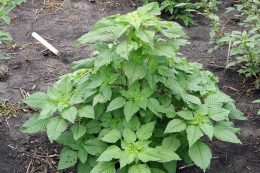 Getting good control of Palmer amaranth and common waterhemp in Kansas has become more of a challenge in recent years. Many populations are now resistant to either glyphosate, triazine, ALS-inhibitor herbicides, HPPD-inhibitor herbicides, PPO-inhibitor herbicides – or a combination of those modes of action. As wheat harvest approaches over the next few weeks in Kansas, producers should plan now for good weed control ahead of double crop soybean.
Getting good control of Palmer amaranth and common waterhemp in Kansas has become more of a challenge in recent years. Many populations are now resistant to either glyphosate, triazine, ALS-inhibitor herbicides, HPPD-inhibitor herbicides, PPO-inhibitor herbicides – or a combination of those modes of action. As wheat harvest approaches over the next few weeks in Kansas, producers should plan now for good weed control ahead of double crop soybean.
There are several ways producers can try to manage pigweeds in double crop soybeans. However, all of them involve higher costs than in the past when one or two postemergence applications of glyphosate could control pigweeds in double crop Roundup Ready soybeans. It is common for pigweed to emerge from the early spring through late summer. Because of the ecology of the winter wheat crop, a higher percentage of pigweed emergence can occur a bit later in the season than on fields where wheat is not growing. This can put additional pigweed pressure on double crop soybean.
The critical weed-free period in soybean is through the V3 developmental stage to avoid economic yield loss. However, due to the vast seed production capabilities of pigweed, a better strategy is to reduce pigweed emergence and ultimately seed production throughout the development of the double crop soybean. There are non-chemical options for controlling pigweeds after harvest. Tillage is an effective option for weed control prior to double crop soybean planting. However there are a few drawbacks to this practice. Long-term tillage studies in southeast Kansas tend to show a yield advantage to no-till double crop soybean vs. tillage prior to soybean planting. This is likely due to having some residue during a hot and dry part of the season to help cool the soil and conserve moisture. In addition, tillage may slow double crop soybean planting in an already shortened growing season that may negatively impact yield.
Burning wheat stubble can provide good weed control, although many producers have moved away from this practice for a number of reasons including loss of residue, loss of nutrients, depletion of soil organic matter, and safety.
